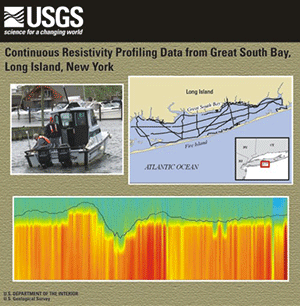Open-File Report 2011–1040
 AbstractAn investigation of submarine aquifers adjacent to the Fire Island National Seashore and Long Island, New York was conducted to assess the importance of submarine groundwater discharge as a potential nonpoint source of nitrogen delivery to Great South Bay. Over 200 kilometers of continuous resistivity profiling data were collected to image the fresh-saline groundwater interface in sediments beneath the bay. In addition, groundwater sampling was performed at sites (1) along the north shore of Great South Bay, particularly in Patchogue Bay, that were representative of the developed Long Island shoreline, and (2) at sites on and adjacent to Fire Island, a 50-kilometer-long barrier island on the south side of Great South Bay. Other field activities included sediment coring, stationary electrical resistivity profiling, and surveys of in situ pore water conductivity. Results of continuous resistivity profiling surveys are described in this report. The onshore and offshore shallow hydrostratigraphy of the Great South Bay shorelines, particularly the presence and nature of submarine confining units, appears to exert primary control on the dimensions and chemistry of the submarine groundwater flow and discharge zones. Sediment coring has shown that the confining units commonly consist of drowned and buried peat layers likely deposited in salt marshes. Low-salinity groundwater extends from 10 to 100 meters offshore along much of the north and south shores of Great South Bay based on continuous resistivity profiling data, especially off the mouths of tidal creeks and beneath shallow flats to the north of Fire Island adjacent to modern salt marshes. Human modifications of much of the shoreline and nearshore areas along the north shore of the bay, including filling of salt marshes, construction of bulkheads and piers, and dredging of navigation channels, has substantially altered the natural hydrogeology of the bay's shorelines by truncating confining units and increasing recharge near the shore in filled areas. Better understanding of the nature of submarine groundwater discharge along developed and undeveloped shorelines of embayments such as this could lead to improved models and mitigation strategies for nutrient overenrichment of estuaries. |
First posted August 3, 2013 For additional information contact: Part or all of this report is presented in Portable Document Format (PDF); the latest version of Adobe Reader or similar software is required to view it. Download the latest version of Adobe Reader, free of charge. |
Cross, V.A., Bratton, J.F., Kroeger, K.D., Crusius, J., and Worley, C.R., 2013, Continuous resistivity profiling data from Great South Bay, Long Island, New York: U.S. Geological Survey Open-File Report 2011-1040, available at https://pubs.usgs.gov/of/2011/1040/.